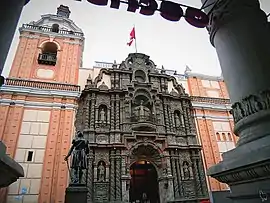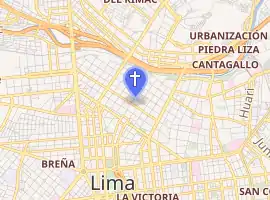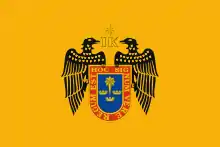Basilica and Convent of Nuestra Señora de la Merced, Lima
The Minor Basilica and Convent of Nuestra Señora de la Merced is a church, designed in the Baroque style known as Churrigueresque, located in Lima, Peru. The church was built under Friar Miguel de Orenes in 1535. The Blessed Virgin Mary of Mercy, the patroness of the Peruvian Armed Forces, is venerated in the Basilica. The Mercedarians not only evangelized the region but helped develop Lima by building many of the churches preserved today.[1]
| Basilica y Convento de Nuestra Señora de la Merced | |
|---|---|
 Façade | |

| |
| Location | Lima |
| Country | Peru |
| Denomination | Roman Catholic |
| Membership | Order of the Blessed Virgin Mary of Mercy (Mercedarians) |
| History | |
| Founded | 1535 |
| Dedication | Virgin of Mercy |
| Architecture | |
| Style | Churrigueresque |
| Completed | 1765 |
Location
The Basilica and Convent of Nuestra Señora de la Merced is at the intersection of block 6 of Jirón de la Unión (Calle La Merced) and the first block of the Jirón Antonio Miró Quesada (Calle Jesús Nazareno), in the historic center of Lima.
History


.jpg.webp)
.jpg.webp)
The convent and the church of Nuestra Señora de la Merced are as old as the city of Lima. According to historic documents, the lands where the convent and the church were built belonged to the Order of the Blessed Virgin Mary of Mercy. On April 13, 1534, Captain Francisco de Becerra donated 6,000 pesos to the Convent of La Natividad de Nuestra Señora, later renamed the Convent of la Madre de Dios de la Merced. Captain Francisco de Becerra and his wife are interred in the church crypt. The Mercedarians are a religious order that came to Peru to educate the conquered indigenous people. The first church was made of wood; the current structure is built of adobe and brick. The Baroque portal was carved in 1591 by Cristóbal Gómez.
In 1589, three years after an earthquake struck the growing city, Alonso de Morales added a square tower to the church, considered the first high-rise structure in colonial Lima. Three years later the architect Cristóbal Gómez rebuilt the primitive cloister the convent of Santo Domingo as a model.
The church chapel of La Cofradía de Nuestra Señora de Agua Santa contained many works of art in the style of Juan Gómez de Mora.[1] The convent refectory contained a two vara (about 1.67 m) sculpture of the Virgin of Mercy carved in 1603 by the Sevillian Martín Alonso de Mesa and an earlier (May, 1600) 9 by 5 vara painting by Angelino Medoro.[1]
In 1608, the central nave was remodeled and extended along with two collateral naves. The redesign resulted a basilica plant of three open naves with a wide crosier. The process involved replacing chapel walls with half domes and summit lanterns, thus creating arches.
This modification of the primitive Isabelline style church, from a single nave with lateral chapels to a three-nave and great crosier structure significantly transformed the interior of the church.[1] The style was duplicated by other Lima churches and spread as an architectural concept throughout South America.
The earthquake of 1609 delayed work on the remodeling of the church. The work resumed on January 5, 1613, when Alonso de Arenas and Andrés de Espinoza coordinated the construction of the main chapel, two side chapels, and the transept. In 1687, another earthquake destroyed parts of the church and the Mercedarian convent. Francisco Javier Domínguez was charged with the rebuilding effort. In 1696, the current stone portal was constructed.
Between the earthquakes of 1687 and 1746, which destroyed a significant part of the church and the convent, the following additions were made:
- In 1702, Juan Rojas completed the altarpiece of the Virgin of the Remedies.[1]
- By August 30, 1714, Friar Miguel Adame painted the four evangelists for the chapel of Jesus Nazarene, gilded by Juan José Ramírez Capitán.
- In 1730 the Virgin of Mercy is declared "Patroness of the Fields of Lima" and taken out for the first time in procession.[1]
- In 1739, engraver Juan Francisco Rosa created the statue of the Lord of Help.
The reconstruction of the church and the convent after the earthquake of 1746 lasted for most of the second half of the 18th century. This reconstruction was also impacted by a devastating fire in the sacristy and other parts of the church on April 24, 1775.
The most important reconstruction work visible today are the following:
- Between 1759 and 1762 the tower, main staircase, and interior balconies.
- Between 1762 and 1765 the portal of Cristóbal Caballero.[1]
- Between 1765 and 1768 dome ornaments and the sacristy.
- In 1774 the library.
- In 1775 more sacristy construction.
- Between 1777 and 1780 the second floor of the main cloister.
- Between 1781 and 1786 the portería, altars of the main cloister, and preparation of the paintings of the life of St. Peter Nolasco in the main cloister.
- Between 1783 and 1792 thirteen of the main cloister paintings on the life of the founder of the order were created by Julián Jayo, under the direction of Friar Gabriel García Cabello. Additional paintings were created in 1786 by Juan de Mata Coronado and beginning in 1792 by Julián Falte.
- Between 1786 and 1798 the altars of the Virgin of the Costume, St. Raymond Nonnatus, and Jesus Nazarene, along with the Chapter Hall were built. During that same period, the current church bells that announce important religious rites of the church were manufactured and installed.[1]
In 1757, the founder Francisco de León carried the inscription "Be blessed and praised the Sacred Heart of Jesus," in 1775 the founder Pedro Mexía made the "San José", and in 1787, the founder of Lima Calero, who resided in Maravillas, makes the big bell of 1.56 mts. of diameter.
Before the proclamation of Independence of Peru, the presbyter Matías Maestro who introduced Neoclassicism in Lima, rebuilt the altarpiece that was gilded in 1810 by Felix Batlle.[1]
In 1860, the architect Guillermo D'Coudry coordinated restoration work at the church.
But in the early-20th century the façade of the basilica of La Merced, including the portal, was covered with a thick layer of plaster resembling an aspect like the French architecture, this plaster was stuck on the original facade. The plaster was removed in 1940 by Emilio Harth-Terr giving its original appearance.[1]
Reredos and the Virgin of Mercy
.jpg.webp)
.jpg.webp)
The church contains a variety of reredos. The altarpiece is fire-gilded. The center of the altarpiece contains an image of the Virgin of Mercy, declared in 1615 the "heavenly protector of [Lima]." In 1730 the Cabildo named her "Perpetual Patroness of the Fields of Lima,". She also was named patroness of the Arms of Peru by the Constituent Congress in 1823. On September 24 of 1921, President Augusto Leguía, together with the Duchess of Goyeneche, bestowed upon her the honorable title of Gran Mariscala (Great Marshal Woman).
The virgin holds the shackles and scapular of her Religious Order, along with a gold scepter.
The altar of the Holy Christ of Help, a statue made by Juan Martínez Montañés, depicts the supposed conversations of Christ with Priest Urraca.
Further information
The façade is an example of the Liman Churrigueresque with the statue of the Virgin of Mercy in a central niche, surrounded by other images.
The convent now has three cloisters:
The main cloister is large, with corner altars containing baseboards with azulejos.
The Cloister of the Doctors named like that for a series of reliefs that depicts several Mercedarians who were professors of the University of San Marcos. In this cloister, the College of the Virgin of Mercy operated from 1917 to 1972.
The third cloister is called the Novitiate.
The main cloister and cloister of the Doctors are separated by a monumental staircase covered by a dome.
In the library contains colonial religious books and the chair where the Friar Pedro Urraca sat and is now considered a relic. In the sacristy is the historical Cross of the Conquest brought by the Mercedarians.
.jpg.webp)
In the Basílica y Convento de la Merced some niches contain statues depicting the noble indians Lord of Huanca and the Lord of Cachuy and regional invocations of Jesus Crucified.
Friar Urraca
Friar Pedro Urraca was born in Villa de Jadraque in Aragón, Spain, in 1583, at the age of 19 traveled to Peru. Legends report that the ship he traveled on to Peru was nearly shipwrecked because of a great storm that endangered the lives of the crew. Pedro Urraca offered his life to the Virgin for the safety of the crew and himself. The sea settled and the ship continued to safely Quito where Pedro Urraca began his novitiate. He was next sent to Peru. During his life he wore cilice and iron chains on his body as penance. After thirty years the chains were embedded in the flesh producing deep sores. Doctors withdrew the chains by order of the confessor. After many years he returned to Spain, where he became Spiritual Director for Queen Elisabeth of France, consort of King Philip IV of Spain. Although he was asked to stay at the Court, he returned to Lima where he died on August 7, 1657 at the age of 74. His remains are located in the floor of the church, in the nave of the epistle, where there is an inscription that reads: "In this place and under the earth rests the body of the Servant of God Friar Pedro Urraca de the Holy Trinity". His cause for Beatification began in Rome on April 29 of 1682. His virtues were proclaimed on January 31 of 1981 and he was declared Venerable by Pope John Paul II.
See also
References
- "La Gran Mariscala del Perú: Nuestra Señora de la Merced, Perú (24 de septiembre)", forosdelavirgen.org
Bibliography
- Collection “Documental del Perú,” Lima Region, Volume XV, Third Edition, April 1973, LA MERCED. Levanta su monumental portada de granito en pleno centro de Lima, pages 42-43.
- "Itinerarios de Lima" by Héctor Velarde, Patronage of Lima, Second Edition, 1990, Iglesia y Convento de La Merced, pages 53–55.
- "Guide to Peru", Handbook for travelers, 6th. Edition, by Gonzalo de Reparaz Ruiz, publisher Ediciones de Arte Rep, Lima - Peru, Book published in English by the Tourism Promotion Fund of Peru - FOPTUR, La Merced. (Church and Convent of), pages 93–95.
